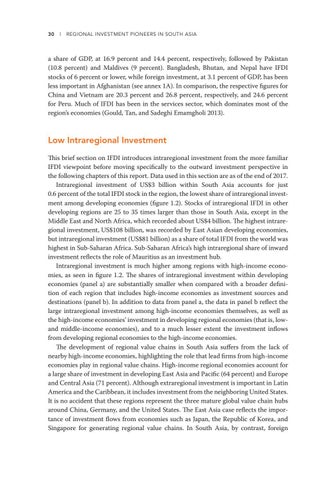30 l REGIONAL INVESTMENT PIONEERS IN SOUTH ASIA
a share of GDP, at 16.9 percent and 14.4 percent, respectively, followed by Pakistan (10.8 percent) and Maldives (9 percent). Bangladesh, Bhutan, and Nepal have IFDI stocks of 6 percent or lower, while foreign investment, at 3.1 percent of GDP, has been less important in Afghanistan (see annex 1A). In comparison, the respective figures for China and Vietnam are 20.3 percent and 26.8 percent, respectively, and 24.6 percent for Peru. Much of IFDI has been in the services sector, which dominates most of the region’s economies (Gould, Tan, and Sadeghi Emamgholi 2013).
Low Intraregional Investment This brief section on IFDI introduces intraregional investment from the more familiar IFDI viewpoint before moving specifically to the outward investment perspective in the following chapters of this report. Data used in this section are as of the end of 2017. Intraregional investment of US$3 billion within South Asia accounts for just 0.6 percent of the total IFDI stock in the region, the lowest share of intraregional investment among developing economies (figure 1.2). Stocks of intraregional IFDI in other developing regions are 25 to 35 times larger than those in South Asia, except in the Middle East and North Africa, which recorded about US$4 billion. The highest intraregional investment, US$108 billion, was recorded by East Asian developing economies, but intraregional investment (US$81 billion) as a share of total IFDI from the world was highest in Sub-Saharan Africa. Sub-Saharan Africa’s high intraregional share of inward investment reflects the role of Mauritius as an investment hub. Intraregional investment is much higher among regions with high-income economies, as seen in figure 1.2. The shares of intraregional investment within developing economies (panel a) are substantially smaller when compared with a broader definition of each region that includes high-income economies as investment sources and destinations (panel b). In addition to data from panel a, the data in panel b reflect the large intraregional investment among high-income economies themselves, as well as the high-income economies’ investment in developing regional economies (that is, lowand middle-income economies), and to a much lesser extent the investment inflows from developing regional economies to the high-income economies. The development of regional value chains in South Asia suffers from the lack of nearby high-income economies, highlighting the role that lead firms from high-income economies play in regional value chains. High-income regional economies account for a large share of investment in developing East Asia and Pacific (64 percent) and Europe and Central Asia (71 percent). Although extraregional investment is important in Latin America and the Caribbean, it includes investment from the neighboring United States. It is no accident that these regions represent the three mature global value chain hubs around China, Germany, and the United States. The East Asia case reflects the importance of investment flows from economies such as Japan, the Republic of Korea, and Singapore for generating regional value chains. In South Asia, by contrast, foreign

